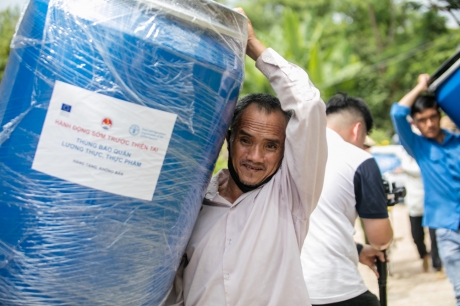Anticipatory action... in action in Viet Nam
The race to mitigate the impact of Typhoon Noru on lives and livelihoods
At first, there didn't seem to be much reason for concern. By the end of it, the trail of destruction had left few homes, crops and livestock unscathed.
Nguyen Hue, an 84-year-old farmer, recalls: “When the first warnings came through over the loudspeakers, we went to take shelter nearby in a neighbour’s stronger house with a second storey. We only have a one-storey house here, and it is weak. We sat through the night hearing the strong winds blow through.”
The Category 1 typhoon ripped through Da Nang and three other provinces of Viet Nam, tearing roofs off of houses, destroying fields, harming and even killing people and livestock.
And yet, the impact could have been much worse.
That's in no small part due to the anticipatory action that the Food and Agriculture Organization of the United Nations (FAO) rolled out before Typhoon Noru struck in late September 2022.
As Hoang Thi Thuan, a 59-year-old from the Quang Tri province who fell victim to the typhoon's wrath, later put it: “I had a means of ensuring we were not only safe, but we could eat and buy some extras.”
Typhoon Noru unfolds
The European Centre for Medium-Range Weather Forecasts (ECMWF) first issued alerts of a possible tropical storm on 22 September, six days before expected landfall on Viet Nam's Quang Binh province. FAO and the Viet Nam Disaster Management Authority (VDMA) decided to closely monitor how the situation might evolve.
Sure enough, by noon of the next day, the ECMWF had upgraded its forecast to a potential typhoon hitting the central provinces in the coming days.
Communities in these provinces are no strangers to typhoons. But while they have shown remarkable resilience in the face of these recurring and increasingly extreme weather shocks, they are struggling to cope in recent years, owing in part to the impact of a global pandemic and the ensuing economic crises.
On Saturday, 24 September, wind speeds were forecast to pass the trigger threshold of 90 kilometres per hour, and the typhoon was officially named Noru.
That's when FAO's anticipatory actions kicked in. Within 48 hours, actions were implemented in the six communes closest to the predicted landfall of Typhoon Noru.

